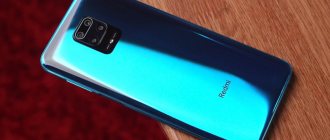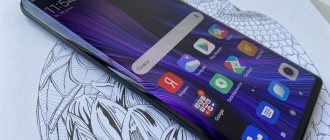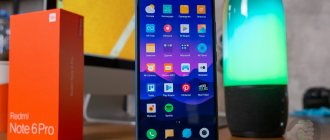A few days ago, Xiaomi announced that sales of the entire Note 9 series exceeded 20 million units at the end of the third quarter of 2022. Redmi Note 9T 5G is another new smartphone from this series, which already includes the 9, 9 Pro and 9S models. All of them do not have a single stylistic line, but they cost about the same money.
Redmi Note 9T 5G in our country will be sold in two versions: 4 GB + 64 GB and 4 GB + 128 GB. The new Note 9T 5G is Xiaomi's fast answer to the Realme 7 5G, an affordable 5G smartphone. At the start of sales, the 9T 5G costs a little more than Realme, although it uses the same MediaTek Dimensity 800U processor, has the same battery capacity, NFC, and a fingerprint scanner in the side power button.
The Realme competitor's advantage is a 120Hz refresh rate display, 180Hz touch sampling and an ultra-wide-angle camera, which the new Redmi doesn't have, which is a bit confusing. During the days of the world premiere, I was able to check whether the Xiaomi Redmi Note 9T 5G is suitable for the so-called middle shelf.
Specifications Redmi Note 9T 5G
| Manufacturer | Xiaomi |
| Series | Xiaomi Redmi Note |
| Segment | Mid-range smartphone |
| operating system | Android 10 |
| System overlay | MIUI 12 |
| Display | |
| Screen diagonal | 6.53 inch |
| Screen resolution | 2340x1080 pixels |
| Matrix type | IPS LCD |
| Pixel Density | 395 ppi |
| CPU | |
| Processor model | MediaTek Dimensity 800U 5G |
| Number of Cores | 2×Cortex-A76 (2.4 GHz) + 6×Cortex-A55 (2 GHz) |
| Graphics accelerator | Mali-G57 MC3 |
| Memory | |
| RAM | 4 GB RAM |
| Inner memory | 64/128 GB UFS 2.1/2.2 |
| microSD card support | Yes, up to 512 GB |
| Main camera | |
| Matrix resolution | 48-MP |
| Aperture brightness | f/1.79 |
| Optical stabilization | No |
| LEDs | Yes |
| Autofocus | With phase detection |
| Additional cameras | 2MP f/2.4 macro lens + 2MP depth sensing |
| Front camera | |
| Matrix resolution | 13-MP |
| Aperture brightness | f/2.25 |
| Connection | |
| LTE | Yes |
| WiFi | 802.11 a/b/g/n/ac |
| Bluetooth | 5.0 |
| GPS | GPS/A-GPS/GLONASS/BDS |
| NFC | Yes |
| USB | 2.0 Type-C |
| Dual SIM cards | Yes |
| Security and sensors | |
| Fingerprint's scanner | Yes |
| Sensors | Accelerometer, gyroscope, proximity, lighting, digital compass, IR |
| Battery | |
| Battery capacity | 5000 mAh |
| Removable battery | No |
| Fast charging | Yes, 18 W |
| Dimensions and weight | |
| Dimensions | 161.96×77.25×9.05 mm |
| Weight | 199 grams |
| Price | |
| Redmi Note 9T 4/64 GB (on sale) | From RUR 15,183 |
| Redmi Note 9T 4/128 GB (on sale) | From RUR 18,998 |
Equipment
A classic set of components. In addition to the phone, the box also contains:
· power adapter with fast charging;
· USB cable – USB Type-C for charging;
· Silicone Case;
· technical literature;
· a paperclip to remove the card tray.
Everything important is in place, nothing superfluous. The smartphone screen already has a protective film pasted on it, which is great. The box itself is made of thick cardboard and looks good, but everything inside is cheap: the adapter and cable are packed together in one compartment, part of the box is completely empty, covered with thin cardboard.
Design and appearance
The design of the Redmi Note 9T 5G should appeal to traditionalists, as the smartphone doesn't particularly stand out.
In front we have a display with small frames (the bottom one is wider) and a small hole in the left corner for the selfie camera. On the top edge there is a surprise – IRDA or IR port, on the bottom – a 3.5 mm headphone jack and USB-C. The fingerprint scanner is placed in the power button, which is very pleasing. In the era of masks, this is a convenient and fast way to protect data.
In the center of the rear panel there is a round module of the main cameras, reminiscent of a washing machine window. Although it protrudes beyond the body, the smartphone does not sway from side to side when lying on a flat table, even without a case. But what Xiaomi was most pleased with was the presence of two speakers - an excellent solution for fans of YouTube and Netflix.
The new Redmi Note weighs less than 200 g, because its back cover is made of plastic. For me, the advantage is that the case has a pleasant texture that does not leave fingerprints, and the gadget itself lies securely in the hand. The case is splash-proof, but does not have the full IP68 rating.
About useful functions
You can control your TV or air conditioner via the infrared port; the built-in application makes friends with household appliances, turning your phone into a control panel. The port is located on the top end next to the microphone hole.
Illustration: Svetlana Chuvileva / Wylsacom Media
On the opposite side there is a 3.5 mm headphone jack; they decided not to abandon it in this model. But the hole was made somehow crookedly, perfectionists will suffer. Although this does not affect the work, it does not look neat.
The sound in the headphones is normal, but I liked the volume of the stereo speakers. Not a separate speaker, of course, but by phone standards the Redmi Note 9T plays decently.
I will say succinctly about the work of GPS: everything is in order, navigation works accurately.
There are quite a lot of pre-installed programs, but everything unnecessary can be removed if you don’t need TikTok and don’t plan to rent a hotel through Booking.
I would like to praise separately for the presence of NFC; the chip is not found in all Redmi, and living without it is not so convenient.
The phone has a universal tray for three cards: you can immediately install a pair of SIM cards and supplement them with a memory card.
Smartphone display
The only criticism you might have about the Redmi Note 9T 5G's display is that it's not AMOLED and doesn't offer a fast refresh rate. Of course, AMOLED panels are not the norm in this segment, but rival Realme already has a better refresh rate in its 7 series.
The screen here is DotDisplay, that is, with a hole for the front camera, has a size of 6.53 inches and FHD+ resolution. These are very good parameters for multimedia content consumption. The display is also not the brightest (450 nits), but there is nothing tragic about it.
At night, the brightness can be dimmed almost completely (so as not to dazzle) - there is a special option in the menu for this. In the current version of the software, the automatic backlight works too aggressively, or rather, the panel is too dark unless we manually increase the brightness. I'm glad that the Note 9T 5G screen is protected by Gorilla Glass 5.
Screen and image quality
The front side of Xiaomi Redmi 9T received a large 6.53-inch screen with Full HD+ resolution or 1080 x 2340 pixels. At the same time, the aspect ratio was 19.5:9, and this is exactly the same as on Redmi Note 9T. In addition, the presence of a drop-shaped cutout for the selfie camera does not make the device stand out much from other models of the Redmi brand.
As for the frames around the screen, they are quite large, so the usable area of the occupied screen was only 83.4%. And the pixel density per inch is 395 ppi. The screen is also protected by Corning Gorilla Glass 3.
Considering its price, many competitors only have HD screen resolution. But the Redmi 9T model received Full HD resolution and this is really a great feature.
I also liked the color scheme, contrast and even the wide viewing angles. But the maximum brightness level is quite weak. Typical brightness was 400 nits. Therefore, using the screen outdoors in bright sunny weather will not be entirely comfortable.
Of course, this is a budget screen, so it only uses a 60Hz refresh rate. But this value is sufficient for everyday use. I think that such a smartphone is not bought for heavy games. A large number of functions and features are available in the settings section. For example, this is reading mode, night mode, color choice, dark or light theme and much more.
Cameras Redmi Note 9T 5G
The main camera system is a drawback of the Note 9T 5G, in my opinion. Probably due to cheaper production, the smartphone only has one “real” camera. The main 48-megapixel optics is supported by a 2-megapixel macro lens and a 2-megapixel depth sensor. At this price point of the market, we should have access to an additional ultra-wide-angle lens.
It must be admitted that photographs from the main lens are of very good quality, although this only applies to photographs taken in conditions with sufficient lighting. In the dark, the Redmi Note 9T 5G smartphone takes relatively good pictures, although at night everything doesn’t look so rosy (rather bad).
The camera app interface is well laid out, although the idea that the default lens being selected reverts to default settings isn't the best. Everything can be changed in other settings, but a huge percentage of users will not do this (the statement mainly concerns disabling HDR mode by default).
For professionals who are familiar with Photoshop, there is a RAW mode. As for shooting video, 4K can be recorded on the Xiaomi Redmi Note 9T camera - only with a tripod (there is no stabilization). In FULL HD mode, stabilization works very smoothly, although only at 30 frames per second, at 60 frames there is no stabilization.
Sample photos
By default, the smartphone takes pictures at 12 megapixels, but if you wish, you can turn on the maximum quality mode and select 48 megapixels. If you don’t bother and compare frames on the monitor, you won’t feel the difference and you can safely limit yourself to the basic settings.
The quality is good during the day, but in poor lighting it turns out differently: if a static scene can be saved by using the night mode, then the dynamics are getting worse.
Here's an example: at the top is normal mode, and at the bottom is night mode. There's a little more detail and less noise. But I won’t say that the difference is very critical:
During the day, in good lighting, the main camera produces decent results - natural colors, good detail. Here are examples:
The front camera retains details, although the artificial intelligence is too clever with the white balance, the photo turns green:
In addition to a good main camera, the phone has a couple of auxiliary lenses. This is a mediocre pair of modules of 2 megapixels each: one for processing frame depth when shooting portraits, the second is used for macro. It’s a pity that there is no ultra-wide-angle, it would be more useful.
You can take a macro photo, but the quality is very low:
System and software
The MIUI 12.0.1 shell is installed on top of the Android 10 OS. It’s a pity that the 5G smartphone from early 2022 does not have the latest version of Android 11. The latest security updates are subsidized in early November.
MIUI is a sleek, lightweight interface with a great design, with settings that are clear and easy to find in the menu. The disadvantages include the fact that Xiaomi persistently pre-installs several or even dozens of different applications that the user could subsequently download from Google Play. The Redmi Note 9T 5G interface also has “ads” for other applications.
I like that MIUI has a Lite mode, which can be useful if we give our phone to a child or an elderly person. The camera app here is also excellent, although saving your own camera settings is now more difficult.
Software
In terms of software, Redmi 9T and Redmi Note 9 share a single proprietary MIUI interface, which is based on Android version 10. The update to the Android 11 operating system has already been rolled out. Xiaomi is not dragging its feet on this, like Samsung or HTC. The MIUI shell has long been time-tested and has proven itself on the positive side. It is well optimized. Works stably on all smartphones. Contains many popular features. Does not suffer from glitches and slowdowns. Easily amenable to deep reconfiguration and personalization. But you can use it simply “as is” without changing anything. From the factory, Xiaomi smartphones are correctly configured, everything is ready to work immediately after the first turn on. What I especially like about MIUI is its advanced power management center, flexible notification control and dark theme.
| Xiaomi Redmi 9T | Xiaomi Redmi Note 9 | |
| OS | MIUI, Android 10 | MIUI, Android 10 |
Productivity and Connectivity
The main advantage of the Redmi Note 9T is, of course, the 5G modem, which is still rare on smartphones in this price category. Yes, I understand that in Russia and the CIS there is no 5G yet, but, you see, it won’t hurt to have support for a new type of network. This could also be useful for future travel to countries that already have 5G.
As for performance, I have nothing to complain about here. In AnTuTu, the test smartphone exceeds the 300 thousand points mark. This result is provided by the new MediaTek Dimensity 800U processor, which is installed inside the main competitor from Realme. The chip is made using 7nm technology and is supported by 4 GB of RAM. The internal memory of the Note 9T 5G can be 64 or 128 GB; the cheaper version has UFS 2.1 memory type, while the more expensive version has UFS 2.2 memory. If necessary, the data memory can be expanded by up to 512 GB using a Micro-SD card.
The Xiaomi Redmi Note 9T 5G smartphone works smoothly, nothing freezes, although launching the camera application is not the fastest. The device supports multi-antenna technology and 4x4 MIMO, there is an NFC module and even an infrared emitter.
Price and where to buy cheaper?
As I am currently saying, from January 11 to 15, you will be able to purchase the Xiaomi Redmi 9T at a very competitive price of just $139.99 using the $20 discount coupon. This is for the basic version, but the 128 GB version will cost you $169.99.
Considering its low cost, I can definitely recommend this smartphone for purchase. It has many interesting features and functions. Therefore, if you wanted to purchase a new smartphone model at an inexpensive price, now would be the best time to order, since the price after January 15 will be significantly higher.
Xiaomi Redmi 9T with 35% discount
★★★★★
$139,99
$227,15
Buy
Aliexpress.com
Battery autonomy
The Redmi Note 9 series boasts high-capacity batteries, and this also applies to the 9T 5G model. We have a battery with a capacity of 5000 mAh.
I've only been using the device for a few days, mostly at home, in Wi-Fi range (and without access to a 5G network), so they can't yet tell you what the battery life is like with a 5G cellular data connection in real-world conditions. So far, without recharging, my smartphone works for 2-3 days, and after 24 hours it has 80% of the battery power left.
If we want to charge the device, the kit includes a 22.5 W charger. However, this charger has more power than the actual maximum capacity supported by the phone's system itself. As a result, Redmi 9T 5G can only be charged with a current power of up to 18 W.
General impression
If we compare it with the rest of the ninth line, the new product turns out to be the most interesting. Its advantages include a 48-megapixel camera, which shoots at the level of mid-price segment devices.
Yes, in terms of power, the Redmi 9T is at the level of its counterparts, so you shouldn’t expect miracles from it while gaming. But the device is perfect for surfing the Internet and watching streaming videos in online cinemas. And don’t forget that you only need to connect your smartphone to the network once every few days thanks to the 6000 mAh battery.
Bottom line
The Redmi Note 9T 5G will still be a bestseller because it is a relatively cheap 5G smartphone. In fact, it is the first (maybe second) Xiaomi mid-range phone to support this technology.
Is it worth buying?
Xiaomi Redmi Note 9T 5G has a number of strong advantages - it's design, a fingerprint scanner in the right place, a headphone jack, decent performance, excellent software and a battery life. But, it still lacks something, for me it is greater versatility of the camera system.
Redmi Note 9T on AliExpress
Battery, battery life and charging time
The surprising news for me was the battery capacity on the Xiaomi Redmi 9T. Here the manufacturer decided to install a 6000 mAh battery. This is a good indicator when compared even with Redmi Note 9T, which only has 5000 mAh. Yes, it is worth mentioning here that the Poco M3 model has only the same battery capacity.
During my tests at the end of the first day, the device was discharged to 41%. This is a very good result, despite the fact that I used the smartphone without regret and checked all the necessary functions. For example, I ran tests on various benchmarks, played heavy games, and even ran camera tests. Thus, with everyday use, the smartphone can easily work for 2.5 days or even more.
Full charging time via an 18W power adapter took me a bit, about 2 hours and 33 minutes.











